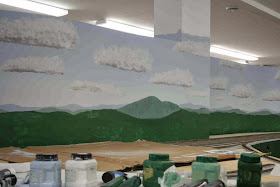Following the push to get the railroad ready for its first
operations, I took a breather on concentrated tasks. Two issues highlighted by the first operating crew were
worked on—switch point gauge and adding to the car fleet. The switch point gauge issue has been
easy to address. It involves
melting the solder for the curved stock rail at the two printed circuit board
(pcb) ties closest to the point ends and moving the rail out slightly. I adjust for widest tolerable gauge
outside the points which results in minimum check gauge at the points with
their extra width. I also note the
FastTracks ™ instructions call for filing the points to a sharper point than I
have been doing.
As to the car fleet, a quick search through my moving boxes
quickly found another ten chip gondolas and a half dozen tank cars. I also located fifteen Athearn lumber
box cars needing only modest work to get them into operation. Couplers were changed on all of the
“new” cars, as well as the ExactRail wood chip gons.
Turning back to construction projects, I decided to address
the basic backdrop behind Oakridge.
My prior backdrop efforts provided for Eugene and Springfield. Now I have basic backdrop paint behind
all current track and the roadbed extension out of Oakridge.
Completed Backdrop Base Behind Oakridge.
For the basic backdrop, I continued techniques employed
previously. This included
reworking the basic sky fade from blue to horizon haze to account for a higher
ridge line (horizon) behind Oakridge. http://espeecascades.blogspot.com/2012/11/backdrop-sky.html Clouds
similar to those behind Eugene and Springfield were painted using sea sponges,
though the number of clouds increase as I move geographically East
(up-mountain). I used a similar
three-color terrain effect, though I mixed paint colors for the middle tones to
represent nearer ridges. http://espeecascades.blogspot.com/2014/02/defining-horizon.html Finally,
the immediate nearby ridge height was increased to represent the nearby ridge
at Oakridge. I will return to this
ridge later to add trees— a mix of Douglas Fir and late winter Oaks (The Oak in
Oakridge!).
Salmon Creek and the platform for Pope and Talbot at the
RR-West (geo-East) end of Oakridge.
Backdrop in the “Pryor” area
behind the climbing roadbed.
My initial efforts produced at least one anomaly that I
chose to replace. I created a high
ridge behind Oakridge that stood too tall. After sitting with it for a couple of days, I pulled out the
sky paint to obscure the ridge, returning the focus to Oakridge. This was a good reminder that most
anything in model railroading can be redone for a better effect. This is the
“art” of model railroading. In
this case it really was an art technique that was used!
High ridge and hill behind
Oakridge.
Ridge and hill wiped out by
fresh sky paint.
Replacement backdrop ridge.







